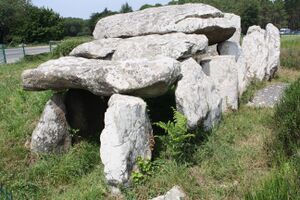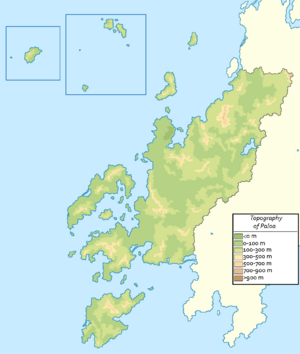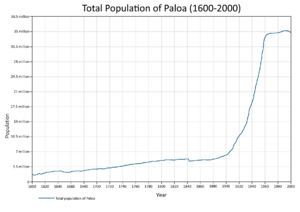Paloa
This article is a work in progress. Any information here may not be final as changes are often made to make way for improvements or expansion of lore-wise information about Gentu. Please comment on this article's talk page to share your input, comments and questions. Note: To contribute to this article, contact User:Philimania. |
Republic of Paloa República de Paloa (Palon) | |||||||||
|---|---|---|---|---|---|---|---|---|---|
| Motto: Vivemos livres ("We live free") | |||||||||
| Anthem: XXX | |||||||||
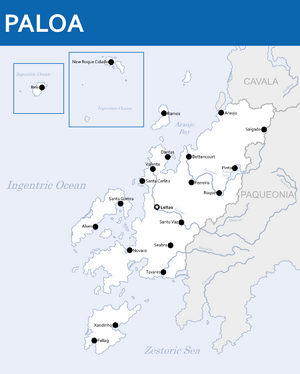 Map of Paloa | |||||||||
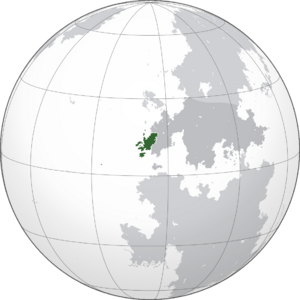 Location of Paloa (Green) in Oranland (Dark Grey) | |||||||||
| Capital | Leitao | ||||||||
| Largest city | Araujo | ||||||||
| Official languages | Palon | ||||||||
| Recognised regional languages | Hestandan | ||||||||
| Ethnic groups (2000) | |||||||||
| Religion (1999) |
| ||||||||
| Demonym(s) | Palon | ||||||||
| Government | Unitary semi-presidential republic | ||||||||
| Filipa Maciel | |||||||||
| Sebastião Rebelo | |||||||||
| Legislature | Congress of Paloa | ||||||||
| Assento | |||||||||
| Baixo Assembly | |||||||||
| History | |||||||||
| c. 100 BCE | |||||||||
| 12 Tebax 1102-3 Pusper 1105 | |||||||||
| 23 Hunyo 1555 | |||||||||
| 26 Pulungana 1843-9 Kunnen 1845 | |||||||||
| 1 Memesa 1848-18 Gunyana 1852 | |||||||||
• Republic | 31 Enero 1957 | ||||||||
| 22 Enero 1960 | |||||||||
| Area | |||||||||
• Total | 360,087.9 km2 (139,030.7 sq mi) (XXX) | ||||||||
• Water (%) | 0.4 | ||||||||
| Population | |||||||||
• 1997 estimate | |||||||||
• 1999 census | |||||||||
• Density | 96.9/km2 (251.0/sq mi) (XXX) | ||||||||
| GDP (PPP) | 1999 estimate | ||||||||
• Total | |||||||||
• Per capita | |||||||||
| GDP (nominal) | 2000 estimate | ||||||||
• Total | |||||||||
• Per capita | |||||||||
| Gini (2000) | low (XXX) | ||||||||
| HDI (1999) | very high (XXX) | ||||||||
| Currency | Palon Ober (PØ) (PLO) | ||||||||
| Time zone | MTS-9 (West Oranland Time) MTS-11 (East Ingentric Time) MTS-12 (New Roque Time) | ||||||||
| Date format | dd-mm-yyyy | ||||||||
| Driving side | right | ||||||||
| Calling code | XXX | ||||||||
| Internet TLD | .pl | ||||||||
| |||||||||
Paloa, officially the Republic of Paloa (Palon: República de Paloa), is a country whose mainland is located on the Hesterlon Peninsula in western Oranland, and whose territory also include the New Roque archipelago and the island of Farata. Paloa is bordered by Paqueonia to the east, Cavala to the north, the Ingentric Ocean to the west, and the Zestoric Sea to the south. Leitao is the capital city of Paloa while Araujo is the largest city.
Paloa was first inhabited by Homo rectus before they went extinct around 300,000–30,000 BP and then by Homo validus and Homo captiosus until the extinction of the Homo validus c. 7,000–6,000 BCE after which Homo captiosus remained. During the Novalithic, people in Paloa experimented with domestication of herding animals, the raising of some cereal crops and fluvial or marine fishing. Metallurgy later appeared during the middle of the 3rd millennium BCE. Like its neighbours, Paloa possesses numerous megalithic sites with 435 known sites as of 2000.
The Calidum Empire first settled in Paloa some time around 1300 BCE. However, they were expelled from the region around the 11th century BCE by the Veragon tribes. Beginning from the 11th century BCE, the region would stay relatively isolated from the rest of the Zestoric until the late 4th century BCE when the Pylosan Empire colonized the region resulting in the founding of several cities that some of which still remains to this day. After the 2nd Zestoric War, Pylosan colonies including those in Paloa were assimilated into the Alarican Empire. In 129, Alarico conquered the rest of the Hesterlon Peninsula, installing a colonial regime over the region. Contemporary historian Oppius (c. 417–481), detailed the final years of Alarican control over Paloa and the rebellions and uprisings led by the Palon people.
- History
Palon has left a profound cultural, architectural and linguistic influence across the globe, with a legacy of around XXX Palon speakers around the world. It is a developed country with an advanced economy and high living standards. Additionally, it ranks highly in peacefulness, democracy, freedom, stability, social progress, and prosperity. A member of the Union of Realms, and the Oranland Trade Union, Palon was also one of the founding members of ARDO, and the Community of Palon Language Countries.
History
Prehistorical Paloa
The region of what is now Paloa was settled by Dordon tribes, giving origin to peoples such as the Veragons and XXX which eventually evolved into the modern Palon people. Present-day Paloa was inhabited by Homo rectus before they went extinct around 300,000–30,000 BP and then by Homo validus and Homo captiosus, both species roaming the border-less region of the Hesterlon Peninsula until the extinction of the Homo validus c. 7,000–6,000 BCE after which Homo captiosus remained. These were subsistence societies and although they did not establish prosperous settlements, they did form organized societies. Paloa during the Novalithic experimented with domestication of herding animals, the raising of some cereal crops and fluvial or marine fishing. Metallurgy later appeared during the middle of the 3rd millennium BCE. Paloa, like its neighbours Cavala and XXX, possesses numerous megalithic sites with 435 known sites as of 2000, some well knowns of which are the Castro stones near present day Pinta, and the Santo Vaz dolmen near Santo Vaz.
Ancient and Antiquity Era
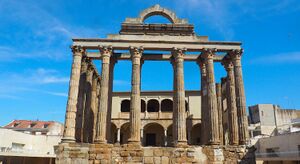
Based on the Calidum chronicles about the Veragon peoples and the interpretation of the abundant archaeological remains throughout the southern and central half of Paloa and some of XXX in XXX during the Ancient Era, it is possible to infer that there was a matriarchal society, with a religious aristocracy. The figures of maximum authority were the chieftain, of military type and with authority in his tribe, and the druid, mainly referring to medical and religious functions that could be common to several tribes. The first documentary references to tribal society in Paloa are provided by chroniclers of Calidum military campaigns such as Apui, Stephinates and XXX among others, about the social organization, and describing the inhabitants of these territories, the Veragese tribes of southern Paloa, also known as the Amossan are described as: "A group of barbarians who spend the day fighting and the night eating, drinking and dancing under the moon". There were other similar tribes and subgroups, chief among them were the Boromans; the core area of these people lay in central Paloa, while numerous other related tribes existed such as the Farovans, Cyconts and Aeroans.
The Calidum Empire first settled in Paloa some time around 1300 BCE. However, they were expelled from the region around the 11th century BCE by the Veragon tribes. Beginning from the 11th century BCE, the region would stay relatively isolated from the rest of the Zestoric until the late 4th century BCE when the Pylosan Empire colonized the region resulting in the founding of several cities that still remains to this day such as Tahu (Tavares), Nun-oni (Novaro), and Donkor (Dantas).
After the 2nd Zestoric War in 1 CE, Pylosan colonies including those in Paloa were assimilated into the Alarican Empire. However, Alarican control over the region suffered a setback in 3 CE when a rebellion began in the south. The Farovans and remnants of the Pylosan army under the leadership of Glycon, a former Pylosan general, fought for control over the southern Hesterlon Peninsula. Alarico sent numerous legions and its best generals to Paloa to quell the rebellion, in 10 CE, Glycon was killed in battle near Tavares resulting in a power struggle among Glycon's allies allowing Alarico to put an end to the rebellion in 11 CE.
In 129, Alarico conquered the rest of the Hesterlon Peninsula, installing a colonial regime over the region. Several works of engineering, such as baths, temples, bridges, roads, circuses, theatres and laymen's homes are preserved throughout the country. Coins, as well as numerous pieces of ceramics, were also found. Contemporary historians include Caninius (c. 360–422) and Oppius (c. 417–481), who detailed the final years of Alarican control over Paloa and the rebellions and uprisings led by the Palon people.
Palon kingdoms, Dardonan Empire, and revolution
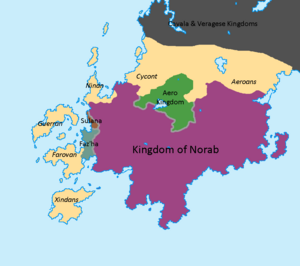
In the early 6th century, the Palon people formed numerous kingdoms in modern day Paloa. The Kingdom of Norab was the post-Alarican kingdom, established in what is now Santo Vaz and one of the largest in the region. Settlements such as Laton (Leitao) and Seabra was founded during this time period.
About during the 6th century it formally became the Kingdom of Norab, when king Romeric made a peace treaty with the Cyconts to the north establishing his control over the region. In 563 Romeric died, leaving the state to be divided by Romeric's two sons, with Alfredo and Filipe ruling simultaneously. Both reigned from 563 to 585, the year in which Parauno reunified the kingdom. From 589, he attempted to unite the Hesterlon Peninsula until his death in 614 after which the kingdom dissolved to numerous kingdoms and city-states. At its height in 608, Parauno's kingdom occupied a territory of about 540,000 km2 (208,495 sq mi).
In 766, the Dardonan Empire invaded the Hesterlon Peninsula from Alarico. An army of roughly 9,000 men led by Alexius I landed on the southern coast near Tavares. He won the Battle of Tahu against Joham, ruler of the Kingdom of Aavalo, securing a Darodan beachhead on the peninsula. By 769, Alexius conquered the southern and eastern coast and controlled most territory south of the Leitao River. However, he sustained severe injuries during the Battle of Laton in Memesa of 770 after which he died. His son Marcian II took his father's role as ruler in Marto the same year. The Battle of Aroun in 774 marked the end of the Darodan conquest of the Hesterlon Peninsula which saw the death of Alvoro, the leader of the last Palon kingdom. In 778, the Hesterlon Peninsula was fully intergrated into the empire as three provinces: Hestanda, Pallas, and Xamida.
Early Palon architecture appeared during this period of Palon history. The Pallas Council also sponsored works of architecture such as the Estrutura de Belas Artes (literally, the Structure of Fine Art) and led to the creation of the Pallaic style of achitecture in the 11th century. The Casa de Lã is the oldest known structure built of this architectural style in the early 9th century.
In 1059, the Hestando people rebelled against the Dardonans followed by numerous other movements most of which failed. Inspired by these uprisings and revolts, Tristico de Vasa, the mayor of Santa Vaz led a revolution against the Dardonans in 1102 known as the Palon Revolution. Tristico would be executed in 1104 after being captured at the Battle of Cume in Gunyana the same year. However the revolution was successful resulting in 1105 with the emergence of the Kingdom of Paloa under Nicolau I, a friend and successor of Tristico who also served as a general during the revolution.
Colonial Era
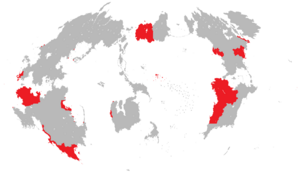
TBA
Contemporary Age
TBA
Geography
The territory of Paloa consists of an area on the Hesterlon Peninsula sometimes referred to as the mainland by most Palon people, and an island and archipelago in the Ingentric Ocean: the island of Farata and the archipelago of New Roque. Paloa has a total land area of 360,087.9 km2 (139,030.7 sq mi) making it the XXX largest in Oranland and the XXX in Gentu.
Mainland Paloa is split by its 2 main river, the Leitao River and the Alemán, both of which flows from XXX and disgorges into their own respective estuaries, before escaping into the Ingentric. The northern landscape is mountainous towards the exterior with large plains towards the interior, the central landscape meanwhile consists of a mixture of flat plains and rolling hills, whereas the south, including the islands and archipelago region, is characterized by rolling plains with a few mountain ranges dotted about the region. Paloa's highest peak is Mount Subir in the Surmonté mountains which measures 897 m (2,942.9 ft) while to lowest point is the Afundar Depression which sits at 104 m (341 ft) below sea level on the Afundar Peninsula in central Paloa. The island and archipelago of Farata and New Roque are scattered within the Ingentric Ocean: Farata as well as New Roque is situated along a range formed by in-plate hotspot geology. Geologically, these islands were formed by volcanic and seismic events. The last terrestrial volcanic eruption occurred in 1848 (Matarmorrer) and minor earthquakes occur sporadically, usually of low intensity.
Paloa's territorial waters, a sea zone over which Paloa have special rights over the exploration and use of marine resources, has 3,776,946 km2. This is the XXX largest territorial waters of Oranland and the XXX largest in Gentu.
Climate
The Climate of Paloa is characterised by an oceanic climate to the north and central region, and a Zestoric climate in the south and in Farata and the New Roque archipelago.
TBA
Environment
TBA
Administrative divisions
TBA
Major cities
TBA
Politics and government
TBA
Military
TBA
Foreign relations
TBA
Economy
TBA
Tourism
TBA
Energy
TBA
Industry
TBA
Infrastructure
TBA
Transport
TBA
Science and technology
TBA
Demographics
The Palon Ministry of Statistics estimates that, according to the 1999 census, the population was 34,926,602 (of which 37% was female, 63% was male). 65.3% of the population is identified as Palon; 21.4% are Hestandan, heavily concentrated in the eastern region of the country; 9.7% of the population are Azoran; while the remaining 3.6% identifies as Qiuese, Neragese etc. In terms of religious belief, as of 2000, 89.2% answered as a part of Terranity with 64.1% (of the total population) identifying as an Altenic and 24.9% as Paxist, 9.5% answered with no religion while 1.3% had other beliefs such as Plecanism and Kaoism. The Palon language is the official language of Paloa with Hestandan as a recognised regional languages in some subdivisions of the eastern region.
Paloa has a population density of 96.9/km2 (251.0/sq mi). Being a developed country, Paloa has a life expectancy of around 82.75 years. Palo additionally has a very low infant mortality rate of 1.4 boys and 1.7 girls per 1,000 births. Historically the rate of reproduction remained above-average with 1.3 children in the mid 1900s, but deteriorated significantly since then with a period of the death rate of Paloa exceeding its birth rate and a slightly shrinking population between 1950 and 1970. The fertility rate of Paloa as of 1995 was estimated at 1.92 children born/woman, the XXXth in Gentu, it remains considerably below the high of 5.02 children born per woman in 1899. In 1996, 65.2% of births were to unmarried women. Like most Oranish countries, Paloa has to deal with low fertility levels: the country has experienced a sub-replacement fertility rate since the 1960s. Paloa subsequently has the XXXth oldest population in the world, with the average age of 44.6 years.
Paloa's congress has approved a budget plan in 1993 for 1994 that includes tax breaks for emigrants that have recently emigrated to Paloa. The expansionary 1994 budget, backed by a left-wing majority in congress, also aims to boost the purchasing power of households while cutting the already low deficit even further. Emigrants will also be allowed to declare only half their taxable income for five years, provided they lived abroad for at least three years. The programme is to run for two years. Emigrants returning in 1998 and 1999 will see their taxes halved as part of the stimulus to bring emigrants to Paloa and revitalize the population and promote continued economic growth – as Paloa struggles with a low birth rate and an ageing population. According to projections by the Ministry of Statistics, Paloa's population will fall to 32.1 million by 2020 from 34.9 million now if the trend continues and the population will continue to age.
Language
TBA
Major cities
TBA
Education
TBA
Religion
According to the 1999 Census, 89.2% of the Palon population was Terranist with 64.1% identifying as Altenic and 24.9% as Paxist, 1.3% consists of other beliefs such as Plecanism, Kaoism, and Hafan. Influences from Naphtoran Traditional Religion and Native Domican Traditional Religion are also felt among many people, particularly in fields related with Traditional Domican Medicine and Traditional Naphtoran Herbal Medicine. Some 4.6% identifies to have no religion, and 4.9% did not give any answer about their religion. Many Palon holidays, festivals and traditions have a Oranish origin or connotation.
The growth of the Palon Empire made its missionaries important agents of colonization, with important roles in the education and conversion of people from all the inhabited continents. The growth of liberal and nascent republican movements during the eras leading to the formation of the Republic of Paloa in 1957 changed the role and importance of organized religion. Paloa is a secular state, the Palon constitution guarantees freedom of religion as an individual constitutional right. Thus the religious view of the state is determined to be neutral and the right of self-determination for religious groups upheld. While the government refrains from recognizing any certain rights of a religious group, and these groups are expected to reject any interaction with politics.
Culture
TBA
Music and art
TBA
Fashion
TBA
Philosophy
TBA
Literature
TBA
Architecture
TBA
Cuisine
TBA
Sports
TBA
Media
TBA



